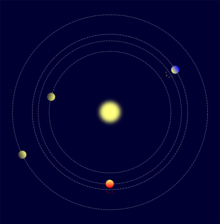Kepler-223
| Observation data Epoch J2000.0 Equinox J2000.0 | |
|---|---|
| Constellation | Cygnus |
| Right ascension | 19h 53m 16.4203s[1] |
| Declination | +47° 16′ 46.3081″[1] |
| Characteristics | |
| Apparent magnitude (g) | 15.903[2] |
| Apparent magnitude (r) | 15.301[2] |
| Apparent magnitude (i) | 15.105[2] |
| Apparent magnitude (z) | 14.963[2] |
| Apparent magnitude (D51) | 15.667[2] |
| Apparent magnitude (J) | 14.095[2] |
| Apparent magnitude (H) | 13.727[2] |
| Apparent magnitude (K) | 13.632[2] |
| J−K color index | 0.463[2] |
| Characteristics | |
| Spectral type | G[3] |
| Astrometry | |
| Proper motion (μ) | RA: −4.270±0.055[1] mas/yr Dec.: −11.068±0.051[1] mas/yr |
| Parallax (π) | 0.5101 ± 0.0313[1] mas |
| Distance | 6,400 ± 400 ly (2,000 ± 100 pc) |
| Details | |
| Radius | 1.095[2] R☉ |
| Surface gravity (log g) | 4.386[2] cgs |
| Temperature | 5,599[2] K |
| Metallicity | -0.211[2] |
| Other designations | |
| Database references | |
| SIMBAD | data |
| KIC | data |

Kepler-223 6:4:4:3

Kepler-223 8:6:4:3
Kepler-223 (KOI-730, KIC 10227020) is a G5V star with an extrasolar planetary system discovered by the Kepler mission. Studies indicate that the Kepler-223 star system consists of 4 planets orbiting the star.[5][3]
Planetary system[]
| Companion (in order from star) |
Mass | Semimajor axis (AU) |
Orbital period (days) |
Eccentricity | Inclination | Radius |
|---|---|---|---|---|---|---|
| b | — | — | 7.3845 | — | — | 3 R |